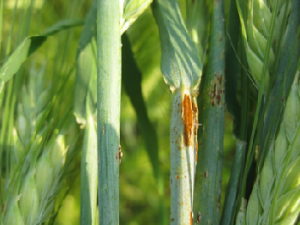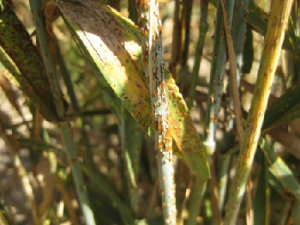Xianming Chen
Stem Rust Update and Recommendations
Stem rust survey
Stem rust of wheat and barley has been widespread in eastern Washington and northern Idaho (Fig.1 and Fig. 2). The disease has been the most severe, especially most widespread, in the Palouse region since 1998. The following summarizes the observations by Mike Pumphrey, Yue Jin (USDA-ARS Minnesota), Anmin Wan, Meinan Wang, Kent Evans, and myself about stem rust throughout the growing season, especially during the last three weeks. A good news is that the stem rust population in our region is not the race group so called “Ug99” which was first detected in Uganda in 1998 and has spread to the Middle-East and South Africa. This preliminary result was obtained by Yue Jin and Les Szabo (USDA-ARS, Minnesota) as expected.
As previously reported, we observed abundant rust infection on barberry bushes (alternate hosts of stem rust) in the Palouse region on May 28. Because of abundant rust on barberry bushes and late planting of spring crops, significant stem rust was predicted in early June (Rust Update June 8, 2012). The earliest stem rust on cereal crops was observed in a winter wheat field next to a barberry bush near Potlatch (Latah County, Idaho) on July 12. There were few stem rust pustules on wheat plants just several yards away from the barberry bush. On July 16, Mike Pumphrey observed hotspots of stem rust in his spring wheat nurseries at the Spillman Farm near Pullman, WA. On July 26, Kent Evans found a couple of stem rust pustules in our spring wheat nurseries north of Pullman. Mike Pumphrey found stem rust in commercial spring wheat, spring barley, and winter wheat in the Whitman and Spokane counties. Rust reached 20-100% incidence and about 1-10% severity in some fields. On July 27, Ken Fuchs brought stem samples from two spring barley ‘Lenetah’ fields south of Spokane with rust severities about 10%. Fungicide application was recommended for fields of late crops and I have heard that some spring barley and wheat fields have been sprayed.
On August 1, we checked the Potlatch barberry site again and grasses around the barberry bush had very severe stem rust. Stem rust developed up to 20% incidence and 40% severity in the winter wheat field part within a couple hundred feet to the barberry bush. The rust level was much less than that of 2008 in the same field spot, probably due to the removal of all bushes (but one) at the field site. In a winter wheat field about a half mile, severe stem rust (up to 60% severity) was found on few green plants. In other commercial fields, stem rust was easy to found, but generally low (less than 10% in most fields) in incidence. In our experimental fields north of Pullman, few spring and winter wheat entries had 100% incidence and up to 60% severity. A stem rust sample of similar severity level was collected by Tim Murray from his winter wheat plots near Pullman.
On August 3, Yue Jin, Mike Pumphrey, Anmin Wan, and a couple of students checked fields from Pullman to Spokane alone HW 27, they saw stem rust developed more severe in spring barley fields and also commonly in winter wheat and spring wheat fields. Yue Jin also found stem rust in a spring barley field with up to 20% severity in Stevens County. The rust level appeared much lower than that in a spring barley field of about 600 acres which had yield loss over 60% in 2007. Yue Jin also found quite heavy infection on Oregon grapes (Mahonia), also alternate hosts for stem rust, and several grass species in Stevens County. Last year, stem rust was easy to find on Mahonia around Pullman, but hard to find this year, probably due to different weather patterns.
On August 10, Anmin Wan and I were checking fields from Pullman to Palouse, Kamiak Butte, Colfax, Steptoe Butte, Garfield, Farmington, Oaksdale, St. John, and Endicott; mostly in Whitman County. Winter wheat was matured and being harvested; spring wheat ranged from soft dough to almost matured; and spring barley was mostly soft dough to matured with one field near Palouse at milk stage. In a total of 34 fields (20 winter wheat, 6 spring wheat, and 8 spring barley fields), stem rust was not found in only 10 fields (3 spring wheat and 7 winter wheat fields). Stem rust was found throughout the areas checked. In general, stem rust was more severe north than south of Palouse and Colfax and more severe east than west of HW 195. Stem rust was found in all checked barley fields and more uniform than in winter wheat and spring wheat fields. In general, spring wheat fields had relatively low stem rust severity and incidence than spring barley as some of the spring barley was planted two to six weeks later than normal planting time and also because some of the spring wheat might have been sprayed for control of stripe rust. Damage of winter wheat crops should be very low (my estimation is between 0 to 2% on an entire individual field level and about 1% in average) for the surveyed areas. However, most severe stem rust (up to 100% incidence and severity; up to 40% yield loss) was found in hot spots (up to an acre) in low parts of some fields with immature plants. Yield loss for spring wheat was estimated below 0.5% for the surveyed areas. In spring barley fields, stem rust incidence ranged from 1 to near 100% and severity from 5 to 60%; yield loss was estimated from 0 to 10% for some entire fields and 3% in average for the surveyed areas.
Recommendations for stem rust management
Although rust management is over for this crop season, more efforts should be taken to reduce stem rust damage. The following lists some general recommendations.
1). Grow and develop resistant cultivars.
Among the wheat cultivars currently grown in the PNW, spring wheat in general is more resistant to stem rust than winter wheat and spring barley. Stem rust reactions are listed in the Seed Buyer’s Guide based on our previous greenhouse data and will be updated based on this year’s field observations. More testing for stem rust to the local stem rust population under controlled greenhouse conditions should be done as stem rust almost always occurred in spots and field testing may be less reliable (except some locations this year). If possible, avoid planting highly susceptible varieties, especially in the Palouse region and further north and east. Based on this year and recent years’ observations, winter wheat varieties “ORCL 102” and “Brundage 96” (or Clearfield Brundage 96) appeared to be highly susceptible; spring wheat “Louise” and “DNS” appeared to have some level of resistance; and spring barley varieties “Lenetah”, “Compland”, and “Radiant” are highly susceptible. More cultivars with resistance to stem rust are needed. Early maturing varieties are less vulnerable to stem rust. Development of early maturing variety can reduce disease damage.
2). Avoid late planting of spring crops
Because stem rust occurs in late growing season, late planted spring crops like many fields in the Palouse area this year are more vulnerable to stem rust damage. If possible, try to plant spring wheat and barley as early as you can.
3). Destroy alternate host plants
Alternate host plants (barberry and Oregon grapes, especially common barberry plants) are essential for starting stem rust in wheat and barley crops in the eastern Pacific Northwest. Stem rust can generate a huge number of different races capable of infecting various varieties. Removing common barberry plants will definitely reduce stem rust by reducing initial rust spores in spring and reduce the number of races. Please keep in mind that common barberry (also called European barberry) can be infected by stem rust, but ornamental barberries currently sold in garden stores and grown in many peoples yards are not hosts for stem rust. We have developed a brochure for identifying common barberry. You can contact Diana Roberts (robertsd@wsu.edu), Tim Murray (tim.murray@wsu.edu), or myself (xianming@wsu.edu) to get one; or check the website www.PNWstemrust.wsu.edu for the brochure. Steve Van Vleet has made the following recommended methods for destroying common barberry plants: “I would recommend Imazapyr for all foliar treatments and triclopyr or imazapyr for cut stump. Always put crop oil with the application. On the cut stump you can use 100 crop oil with the herbicide, then use a brush to apply. Picloram will work fine for cut stump, but I would not use
foliar. Picloram has the ability to move readily with water but as cut stump is perfectly fine. All provide 100% control for cut stump treatment method.”
4) Fungicide application
The fungicides which are used to control stripe rust and other foliar diseases of wheat and barley can be used to control stem rust. Stem rust can be forecasted by infections on barberry plants together with precipitation or moisture in June and July. Checking crops in late season, especially after stripe rust control, is critical for on-time application and without wasting money for control of nothing.
Fig. 1. Stem rust on barley.
Fig. 2. Stem rust on wheat.

